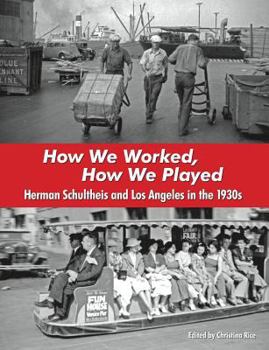How We Worked, How We Played: Herman Schultheis and Los Angeles in the 1930s
Herman Schultheis may have been an engineer by trade, but was a photographer at heart who never seemed to go anywhere without his camera. After relocating to Los Angeles from the East Coast in 1937, Herman and his wife Ethel explored their newly adopted home, far and wide. By the end of the decade, he had snapped well over 5,000 photos. How We Worked, How We Played: Herman Schultheis and Los Angeles in the 1930s, presents a small sampling of this...
Format:Paperback
Language:English
ISBN:0692700579
ISBN13:9780692700570
Release Date:April 2016
Publisher:Photo Friends Publications
Length:152 Pages
Weight:0.63 lbs.
Dimensions:0.3" x 7.4" x 9.7"
Customer Reviews
1 rating
Needs 'zero stars' option--sunk by bad photo choices and weird organization. Best photos on the cove
Published by AKNM , 2 years ago
If you want to see the photos of Herman Schultheis, go to the Los Angeles Public Library website. The address in the book is incorrect-it's tessa (dot) lapl (dot) org, and you need to look up 'collections'. On that page select 'photo collections' and then either search for 'Schultheis' or click 'browse collection' and select 'photographer' then 'Schultheis, Herman' from the sidebar menu that lets you narrow your search. Whomever assembled this book had no clue. Despite Mr. Schultheis taking many photos with both people and context, the editor let about 1 photo in every half-dozen show a reasonable amount of context. It's a photography book. Select the photos that SHOW the context instead of having to describe it in the caption. Even that wouldn't be so bad, except that the captions are no great shakes, either. They often speculate on the emotions of the subjects--but usually neglect to elaborate on the actual physical content of the photo, which CAN be objectively determined (for example, instead of asserting that a store employee is 'bored,' tell us why he was dressed as he was and if this was a common thing in the 1930s.) Given a choice of two or more photos of the same subject, the editor makes baffling choices. Instead of printing a photo that shows a so-so closeup of two women with dozens of people on nondescript benches in the background and telling us it is aboard the ferry to Catalina, they had a choice of at least 2 (possibly more--I'm only 5 pages in to 6,000+ photos on the website) of photos that showed people AND enough of the ship to determine that is is a ship AND nearby land for context--your choice of a view of Avalon or of the lighthouse on the way out of Los Angeles.
The book is divided into categories prefaced by 'How we...' worked, learned, etc. The least compelling one is 'how we grew.' The editor decided random photos of small children needed to be segregated from playing, working, or learning. I think I would have enjoyed this at least slightly more if it had been organized in a more sensible manner... geographically would have worked (Herman and Ethel tour the city-- Herman and Ethel go to the Fair-- etc.)
Oh, and the photos themselves really are amateur. Most seem to be taken on the fly and the subjects, humans and landscape, tend to be blurry. But I would not have rated it lower for that if the photo choices or the descriptions or both had been acceptable. I'll probably give it away but I'm tempted to recycle it lest someone else be equally disappointed. Oh, and the paper is pulpy and cheap-feeling. Almost newsprint-like.
All in all, it tells very little about how people worked, played, or did anything else in L.A. in the 1930s... it doesn't even relate, as the back blurb claims, much of a story about 'two people in love with each other.'





